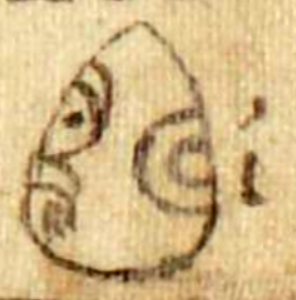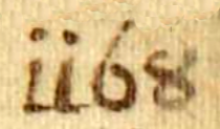Ce Tecpatl (Azca9)
This simplex glyph plus notation for the date One Flint Knife as found in the Azcatitlan Codex, Image 9. This flint knife has an egg shape with the point up. It has two concentric circles that are about half-visible on the right edge. A design that appears on the left side is difficult to make out. To the right of the knife is the Roman number one (“i”). This is the notation that is the companion to the tecpatl, for the year One Flint Knife or 1-Flint Knife. The gloss suggests the date in the European calendar was 1168 C.E.
Stephanie Wood
Four year names repeat in the count of the years, the xiuhpohualli. These are tecpatl (flint knife), calli (house), tochtli (rabbit), and acatl (reed). Each year will have a numerical companion from 1 to 13. Thus, 4 x 13 is 52, which is akin to a century in the European calendar. One Flint Knife is a symbolic date, associated with beginnings, departures, births, and so on, according to Michel Graulich, in his study of the Codex Azcatitlan (1995, v. 1, p. 46, note 11).
Stephanie Wood
ii68
1168
Stephanie Wood
post-1550, possibly from the early seventeenth century.
Jeff Haskett-Wood
pedernales, cuchillos, obsidiana, fechas, calendarios, xiuhpohualli, años

tecpa(tl), a flint knife, https://nahuatl.wired-humanities.org/content/tecpatl
pedernal
Stephanie Wood
The Codex Azcatitlan is also known as the Histoire mexicaine, [Manuscrit] Mexicain 59–64. It is housed in the Bibliothèque Nationale de France, and hosted on line by the World Digital Library and the Library of Congress, which is “unaware of any copyright or other restrictions in the World Digital Library Collection.”
https://www.loc.gov/resource/gdcwdl.wdl_15280/?sp=9&st=image
The Library of Congress is “unaware of any copyright or other restrictions in the World Digital Library Collection.” But please cite Bibliothèque Nationale de France and this Visual Lexicon of Aztec Hieroglyphs.




